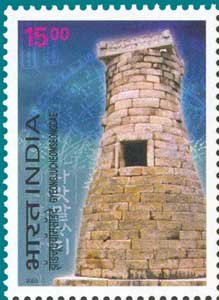Cheomseongdae Astronomical Observatory, Gyeoingju

Technical Data
| Stamp Set | Diplomatic Relations Between India and The Republic of Korea |
|---|---|
| Date of Issue | December 10, 2003 |
| Denomination | Rs. 15 |
| Perforation | comb 13 x 13½ |
| Printer | Calcutta Security Printers Ltd |
| Watermark | No Watermark |
| Colors | Multicolor |
| Catalog Codes |
Michel IN 2004 Stamp Number IN 2042b Yvert et Tellier IN 1768 Stanley Gibbons IN 2179 WADP Numbering System - WNS IN060.03 |
| Themes | Anniversaries and Jubilees | Architecture | Astronomy | Joint Issues | Observatories | Towers | UNESCO World Heritage Sites |
Table of Contents
Cheomseongdae Astronomical Observatory, Gyeongju
Overview:
The Cheomseongdae Astronomical Observatory, located in Gyeongju, South Korea, is one of the oldest surviving astronomical observatories in East Asia. It was constructed in 647 A.D. during the reign of Queen Seondeok of the Silla Kingdom. The name “Cheomseongdae” translates to “star-gazing platform,” highlighting its use in celestial observations.
Purpose:
Cheomseongdae served as an observatory for tracking celestial bodies, which played a critical role in agricultural planning. By monitoring the movement of the stars and planets, it helped determine the appropriate times for farming activities. Astronomy was also tied to politics, as the movement of celestial objects was often interpreted as omens for the kingdom’s fortune.
Design:
The observatory is made of 362 stones, symbolizing the days of the lunar calendar year. It is 9.17 meters high and features a cylindrical stone structure with a square base. The design of Cheomseongdae reflects the advanced understanding of astronomy and architectural techniques of the Silla period. Its shape, with a small opening halfway up the structure, was likely used to make astronomical observations easier, allowing scholars to view the night sky.
Significance:
As one of the most significant historical landmarks of Korea, Cheomseongdae represents the kingdom’s sophisticated knowledge of astronomy and the importance placed on observing celestial phenomena. The observatory is a National Treasure of South Korea and a symbol of the nation’s scientific heritage.
Cultural and Historical Importance:
Cheomseongdae holds immense cultural and historical significance as an enduring relic from the Silla Kingdom and an emblem of ancient Korea’s astronomical and architectural achievements. It continues to be a symbol of Korea’s legacy in science and astronomy, attracting tourists and researchers alike.
